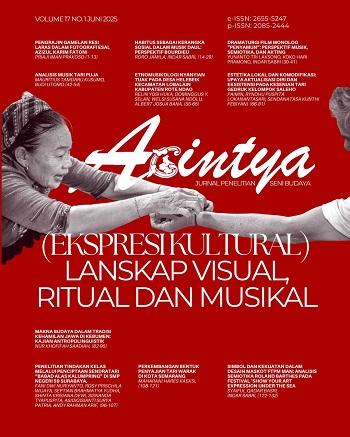CLASSROOM ACTION RESEARCH THROUGH THE CREATION OF THE "BABAD ALAS KALUMPRING" DANCE AT SMP NEGERI 59 SURABAYA
DOI:
https://doi.org/10.33153/acy.v17i1.7126Keywords:
Improved learning outcomes, Dance Drama, Classroom Action Research, Babad Alas KalumpringAbstract
This class action research aims to determine the improvement of the learning outcomes of Cultural Arts students in grade VII of SMP Negeri 59 Surabaya through the creation of a literary work entitled "Babad Alas Kalumpring". This research is motivated by the low involvement and learning outcomes of students in art learning, especially performing arts. Cultural Arts as a subject in junior high school has an important role in shaping creative, appreciative, and expressive characters in students. However, the reality at SMP Negeri 59 Surabaya shows that the learning outcomes of Cultural Arts are still low, especially in the aspect of appreciation and creation of performing arts. Many students lack a holistic understanding of the concept of performing arts and tend to be passive in the learning process. The method used in this study is the Kemmis and McTaggart model class action research which consists of
planning, action, observation, and reflection in two cycles. Data was collected through observation, tests, documentation, and interviews. The results of the study showed a significant increase in material understanding, active participation, and students' skills in creating and displaying artworks. In conclusion, the creation of sendratari based on local stories can be an effective strategy to improve the learning outcomes of Cultural Arts. This study shows that the creation of the "Babad Alas Kalumpring" dance is effective in improving the learning outcomes of Cultural Arts at SMP Negeri 59 Surabaya. Through this project-based creative approach, grade VII A students become more active, creative, and able to work together optimally. The drama creation project encourages an increase in student participation from 70% in Cycle I to 90% in Cycle II, as well as increasing the completeness of cognitive learning outcomes from 68% to 87% of students who achieve grades above KKM.
Downloads
References
Afrilyasanti, R., Basthomi, Y., & Suhartoyo, E. (2025). Involving students as collaborators in developing
learning materials through action research. Educational Action Research, 33(2), 251–273. https://doi.org/10.1080/09650792.2024.2307566
Aldridge, J. M., Rijken, P. E., & Fraser, B. J. (2021). Improving learning environments through whole-school collaborative action research. Learning Environments Research, 24(2), 183–205. https://doi.org/10.1007/s10984-020-09318-x
Bloom, B. S., & Krathwohl, D. R. (1956). Taxonomy of Educational Objectives: The Classification of Educational Goals. In Handbook I: Cognitive Domain.
Efland, A. D. (2002). Art and cognition: Integrating the visual arts in the curriculum. Teachers College
Press.
Juliarta, I. P. B. (2023). Penerapan Teknik Sketsa Dengan Kertas Karbon, Meningkatkan Hasil Belajar Seni Lukis Realis , Siswa Kelas Xi Smk Negeri 1 Sukawati Tahun Pelajaran 2021/2022. Acintya Jurnal Penelitian Seni Budaya, 14(2), 152–162. https://doi.org/10.33153/acy.v14i2.4001
Long, C. S. (2024). Classroom Learning Environment and Action Research in a Science Methods Course for Preservice Elementary Teachers. Journal of Science Teacher Education, 35(8), 821–839. https://doi.org/10.1080/1046560X.2024.2353424
Manfra, M. M. (2019). Action Research and Systematic, Intentional Change in Teaching Practice. Review of Research in Education, 43(1), 163–196. https://doi.org/10.3102/0091732X18821132
Meesuk, P., Sramoon, B., & Wongrugsa, A. (2020). Classroom Action Research-based Instruction: The
Sustainable Teacher Professional Development Strategy. Journal of Teacher Education for Sustainability. https://doi.org/10.2478/jtes-2020-0008
Moller, F., Flego, N., & Arnaudo, L. (2025). Action research for character development in 18 classrooms in Latin America: reflections, learnings and challenges. Educational Action Research, 1–20.
https://doi.org/10.1080/09650792.2025.2465642
Rohidi, T. R. (2011). Seni dalam Pendidikan. Direktorat Jenderal Pendidikan Tinggi, Departemen
Pendidikan Nasional.
Suryani, N. (2017). Pengaruh model project based learning terhadap hasil belajar seni budaya. Jurnal
Pendidikan Seni, 5(1), 12–20.
Tavakoli, M., & Kavoshian, S. (2024). Implementing action research to improve L2 classroom
communication patterns: a grounded theory analysis approach. Educational Action Research, 32(5), 789–806. https://doi.org/10.1080/09650792.2024.2324184
Thomas, J. W. (2000). A REVIEW OF RESEARCH ON PROJECT-BASED LEARNING. In Autodesk Foundation.
Utami, C. D. (2018). Facebook Sebagai Sarana Publikasi Hasil Pembelajaran. Acintya Jurnal Penelitian Seni Budaya, 10(1). https://doi.org/10.33153/acy.v10i1.2286
Wright, P. (2021). Transforming mathematics classroom practice through participatory action research.
Journal of Mathematics Teacher Education, 24(2), 155–177. https://doi.org/10.1007/s10857-019-094521
Downloads
Published
How to Cite
Issue
Section
License
Copyright (c) 2025 nuriyanto Nuriyanto

This work is licensed under a Creative Commons Attribution 4.0 International License.
Author continues to retain the copyright if the article is published in this journal. The publisher will only need publishing rights




